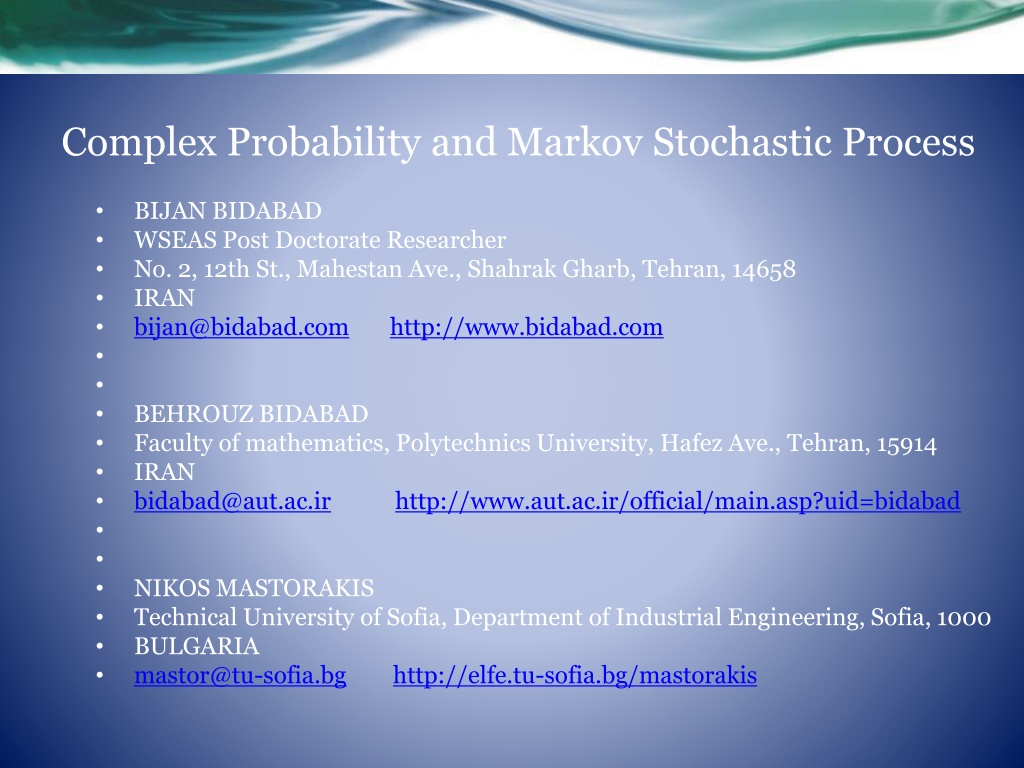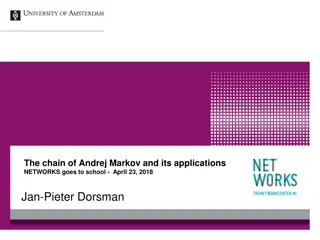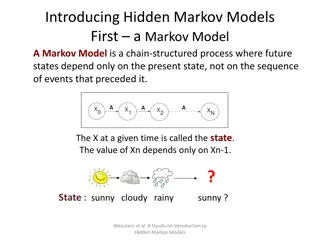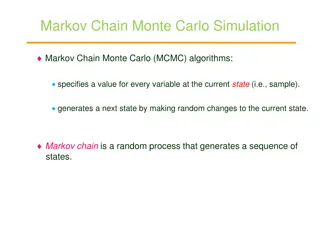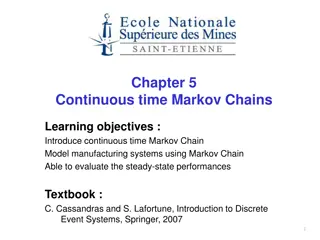Understanding Complex Probability and Markov Stochastic Process
Discussion on the concept of complex probability in solving real-world problems, particularly focusing on the transition probability matrix of discrete Markov chains. The paper introduces a measure more general than conventional probability, leading to the idea of complex probability. Various examples and scenarios are analyzed to illustrate the application and significance of this new measure in problem-solving.
Download Presentation

Please find below an Image/Link to download the presentation.
The content on the website is provided AS IS for your information and personal use only. It may not be sold, licensed, or shared on other websites without obtaining consent from the author. Download presentation by click this link. If you encounter any issues during the download, it is possible that the publisher has removed the file from their server.
E N D
Presentation Transcript
Complex Probability and Markov Stochastic Process BIJAN BIDABAD WSEAS Post Doctorate Researcher No. 2, 12th St., Mahestan Ave., Shahrak Gharb, Tehran, 14658 IRAN bijan@bidabad.com http://www.bidabad.com BEHROUZ BIDABAD Faculty of mathematics, Polytechnics University, Hafez Ave., Tehran, 15914 IRAN bidabad@aut.ac.ir http://www.aut.ac.ir/official/main.asp?uid=bidabad NIKOS MASTORAKIS Technical University of Sofia, Department of Industrial Engineering, Sofia, 1000 BULGARIA mastor@tu-sofia.bg http://elfe.tu-sofia.bg/mastorakis
Abstract This paper discusses the existence of "complex probability" in the real world sensible problems. By defining a measure more general than conventional definition of probability, the transition probability matrix of discrete Markov chain is broken to the periods shorter than a complete step of transition. In this regard, the complex probability is implied.
Introduction Sometimes analytic numbers coincide with the mathematical modeling of real world and make the real analysis of problems complex. All the measures in our everyday problems belong to R, and mostly to R+. Probability of occurrence of an event always belongs to the range [0,1]. In this paper, it is discussed that to solve a special class of Markov chain which should have solution in real world, we are confronted with "analytic probabilities"!. Though the name probability applies to the values between zero and one, we define a special analogue measure of probability as complex probability where the conventional probability is a subclass of this newly defined measure.
Issues and Resolutions Now, suppose that we intend to derive the t-step transition probability matrix P(t)where t 0 from the above (3) and (4) definition of n-step transition probability matrix P. That is, to find the transition probability matrix for incomplete steps. On the other hand, we are interested to find the transition matrix P(t)when t is between two sequential integers. This case is not just a tatonnement example. To clarify the application of this phenomenon, consider the following example. Example 1. Usually in population census of societies with N distinct regions, migration information is collected in an NxN migration matrix for a period of ten years. Denote this matrix by M. Any element of M, mijis the population who leaved region i and went to region j through the last ten years. By deviding each mijto sum of the ithrow of M, a value of Pijis computed as an estimate of probability of transition from ithto jthregions. Thus, the stochastic matrix P gives the probabilities of going from region i to region j in ten years (which is one step transition probability matrix). The question is: how we can compute the transition probability matrix for one year or one-tenth step and so on.
Breaking the Time in Discrete Markov Chain 1 = P X X (7) Where X is an NxN matrix of eigenvectors 1,..., , ,i N i x [ ,...., ] N = X x x (8) and the NxN diagonal matrix of corresponding eigenvalues, { ,..., } N diag = (9) Using (7), (8) and (9) to break n-step transition probability matrix P to any smaller period of time t 0, we do as follows. If 0 for all i {1, ,K}are fractions of n step period and k t n = then, k t i t = = = 1 1 On the other hand, transition probability matrix of n-step can be broken to fractions of n, if sum of them is equal to n. Therefore, any one-step transition probability matrix can be written as, 1 t t = P X X (11) where, N diag = 0 t fraction of it = for any n belonging to natural numbers i 1 i i k = = t t t n P P P 1,...., 1 i (12) (10) 1 j
Discussion on Broken Times The broken time discrete Markov chain is not always a complex probability matrix defined by definition 1. Matrix Pthas different properties with respect to t and eigenvalues. may be real (positive or negative) or complex depending on the characteristic polynomial of P. Since P is a non negative matrix, Forbenius theorem (Takayama (1974), Nikaido (1970)) assures that P has a positive dominant eigenvalue and (28) 0 (Frobenius root) (27) 1 2,..., i N 1 i Furthermore, if P is also a Markov matrix then its Frobenius root is equal to one, (Bellman (1970), Takayama (1974)). Therefore, = (29) 1 i i S (30) 11 With the above information, consider the following discussions. ) (0,1] i a i S
Discussion on Broken Times i t 0 0 i are all t In this case all imaginary part occurs in matrix Pt. positive for i belonging to S if we can decompose the matrix P to two positive semi-definite and positive definite matrices B and C of the same size (Mardia, Kent, Bibby (1982)) as 1 = P C B ) 1,1 , 0, i i b i 0 , t belongs to sets of real and imaginary numbers based on the value of t. In this case Pt belongs to the class of generalized stochastic matrix Q of definition 1. For i be positive definite. ) , (0,1] i i c C i S Pt in this case for 0 t and t N class of generalized Morkov matrices of definition 1. N t d ) (Natural numbers) for and no S In all cases of a, b, and c we never coincide with complex probabilities. Since Pt can be drived by simply multiplying P, t times. ) e t Z (Integer numbers) In this case, Pt is a real matrix but does not always satisfy condition 2 of definition 1. ) f t R Pt is a complex matrix but does always satisfy conditions 2 and 3 of definition 1. i t R , it is sufficient that P belongs to the
Complex Probability Justification Interpretation of the "Complex probability" as defined by definition 1 is not very simple and needs more elaborations. The interesting problem is that, it exists in operational works of statistics as the example 1 discussed. Many similar examples like the cited may be gathered. With this definition of probability, the moments of a real random variable are complex. Although the t step distribution respect to Pt may be complex, they have the same total as . 0 That is, if ( ,..., ) N = (32) Then, t t o o o = = = + P Q U (33) The above remark 8 states that though there exist imaginary transition probabilities to move from state j to k, the total sum of imaginary transitions is equal to zero. On the other hand, after tth step transition, the total distribution has no imaginary part. t of initial distribution with 0 0 01 0 i V o
Summary By summarizing the discrete and continous times Markov stochastic processes a class of real world problems was introduced which can not be solved by each of the procedures. The solutions of these problems coincide with Complex probabilities of transitions that are inherent in mathematical formulation of the model. Complex probability is defined and some of its properties with respect to the cited class are examined. Justification of the idea of complex probability needs more work and is left for further research.
Complex Probability and Markov Stochastic Process BIJAN BIDABAD WSEAS Post Doctorate Researcher No. 2, 12th St., Mahestan Ave., Shahrak Gharb, Tehran, 14658 IRAN bijan@bidabad.com http://www.bidabad.com BEHROUZ BIDABAD Faculty of mathematics, Polytechnics University, Hafez Ave., Tehran, 15914 IRAN bidabad@aut.ac.ir http://www.aut.ac.ir/official/main.asp?uid=bidabad NIKOS MASTORAKIS Technical University of Sofia, Department of Industrial Engineering, Sofia, 1000 BULGARIA mastor@tu-sofia.bg http://elfe.tu-sofia.bg/mastorakis
